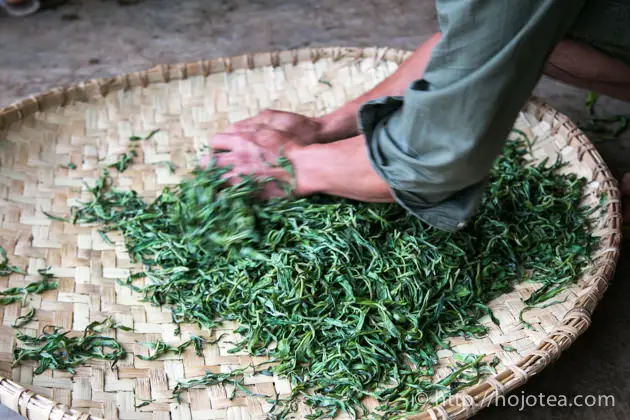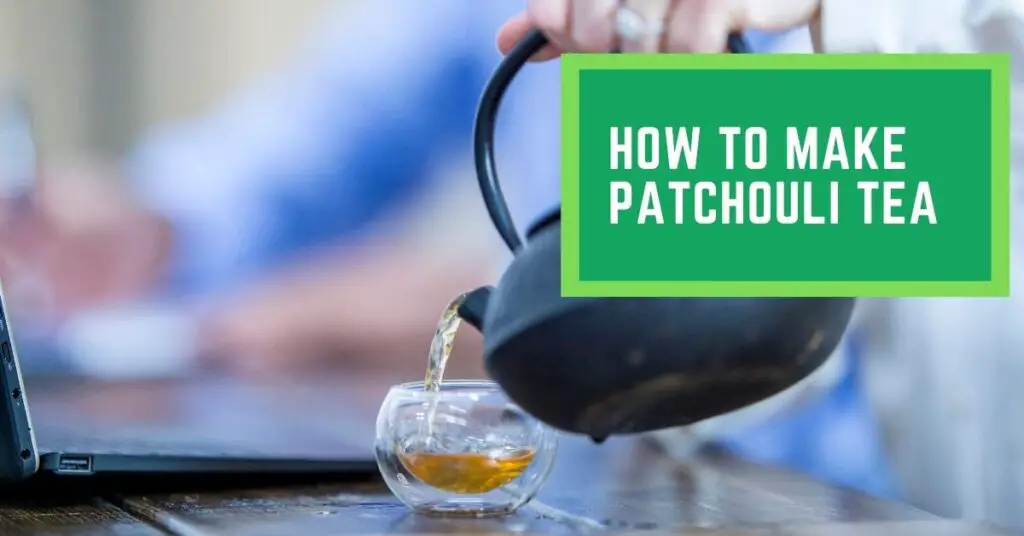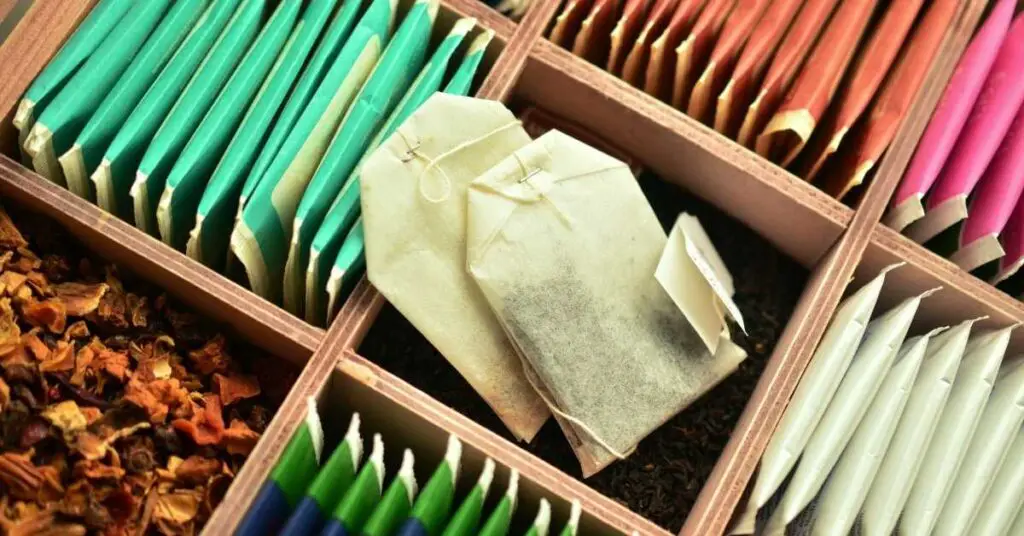Welcome to the enchanting world of tea blending, where creativity meets tradition in a symphony of flavors. Crafting your personalized tea blends is more than a hobby; it’s a sensory adventure that allows you to curate your own tea legacy.
Select the base tea, complement it with herbs or spices, balance ratios, and experiment. Document recipes for future blends. Store in airtight containers. Label for identification. Consider health considerations and allergies. Enjoy your unique tea blend!
From understanding the nuances of tea bases to experimenting with aromatic infusions, this guide will empower you to concoct blends that reflect your unique palate.
Get ready to embark on a journey of taste, aroma, and creativity. Whether you’re seeking a morning boost or an evening calm, this guide will unlock the secrets to crafting teas that are as distinctive as you are. Let’s blend!
Also read: A guide to the world’s most exquisite tea houses and lounges.
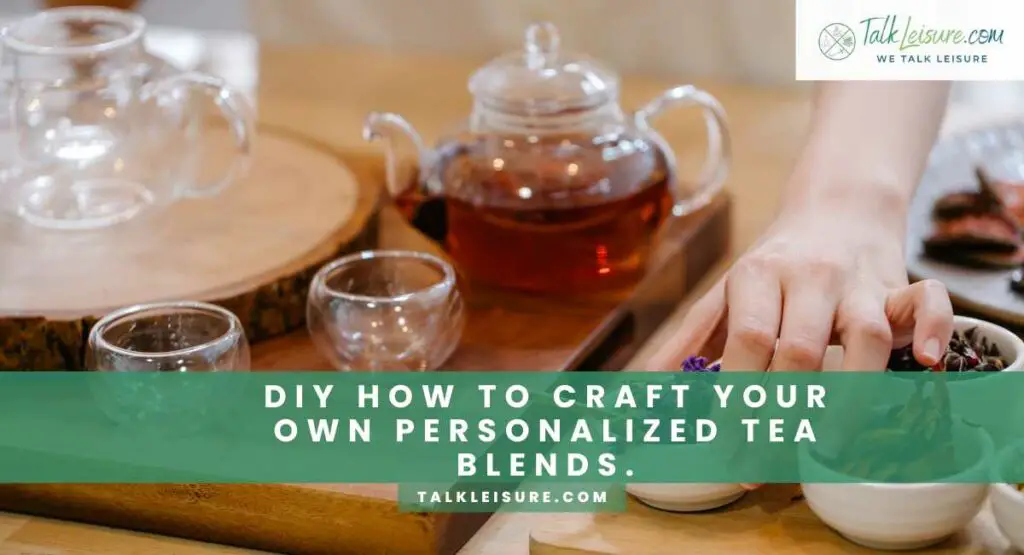
Introduction to Personalized Tea Blends
Brief Overview of the Art of Crafting Tea Blends
Alright, tea enthusiasts, gather around! We’re about to embark on a delightful journey into the world of personalized tea blends. Picture this: you in your cozy kitchen, surrounded by an assortment of aromatic herbs, spices, and teas. It’s like being a mad scientist, but with a much tastier outcome!
Tea blending is an age-old practice that’s part art and part science.
It’s about taking different types of teas, herbs, and flavorings and harmoniously marrying them to create a brew that’s uniquely yours.
Whether you’re after a soothing evening blend or an invigorating morning pick-me-up, the power is in your hands.
Benefits of Creating Your Own Tea Blends
Now, you might be wondering, Why go through the trouble of crafting your own tea blends when you can easily pick up a box from the store? Well, dear reader, the benefits are aplenty!
First off, it’s all about flavor control. You get to decide exactly how much of each ingredient goes into your blend. Love a strong, minty kick? Add a bit more peppermint. Craving a touch of citrus? Toss in some dried orange peel. You’re the master of your own palate!
But wait, there’s more. When you create your own blends, you have the power to tailor them to your specific needs. Need a calming blend to wind down after a hectic day? You got it. Looking for an energy boost to kickstart your morning? No problem. The possibilities are as endless as your imagination.
And let’s not forget the sheer satisfaction that comes from sipping a cup of tea that you, and only you, concocted. It’s like a warm, liquid hug from yourself to yourself.
So, my tea-loving friends, get ready to unlock a world of flavor, creativity, and self-indulgence. Crafting personalized tea blends is not just a hobby—it’s a deliciously rewarding art form. Let’s dive in!
Also read: The mesmerizing process of hand-rolling artisanal tea leaves.
Getting Started: Essential Tools and Ingredients
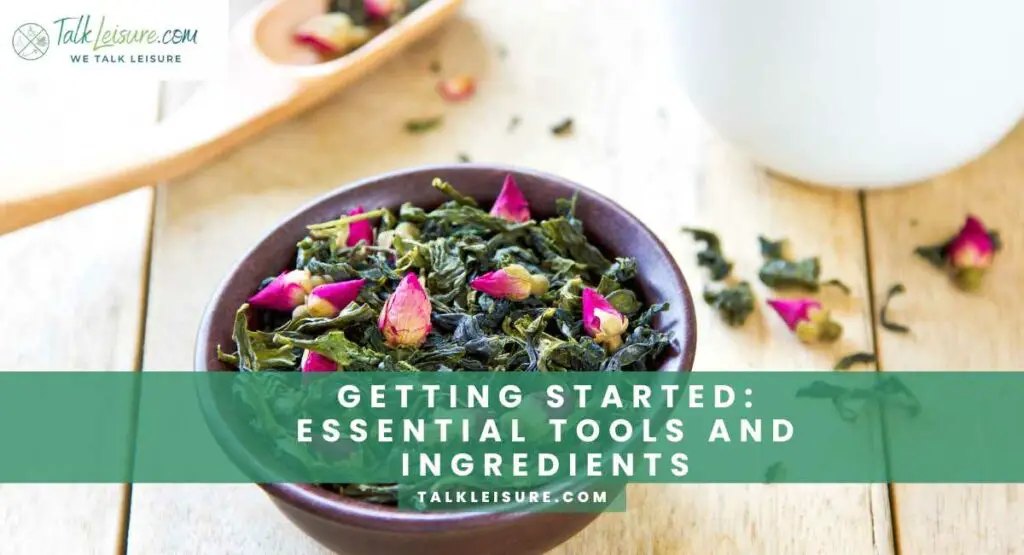
Alright, budding tea alchemists, it’s time to gather our potions and powders! In this section, we’ll cover everything you need to kickstart your tea-blending adventure.
Teas and Herb Selection
First things first, let’s talk about the heart and soul of your blend: the teas and herbs. This is where the magic truly begins. You’ve got a world of options at your fingertips, from the robust notes of black tea to the gentle whispers of chamomile.
Want to infuse a bit of zing with some peppermint? Or perhaps go exotic with a touch of lemongrass? The choice is entirely yours. Feel free to experiment and let your taste buds be your guide. Remember, this is your blend, tailored to your unique flavor preferences.
Additional Flavorings (Optional)
Now, if you’re feeling a tad adventurous, it’s time to consider additional flavorings. These are the secret weapons that can elevate your blend from delightful to downright divine. Think of dried fruits, citrus peels, or even a sprinkle of cinnamon. These little extras can add layers of complexity and character to your brew.
Feel free to raid your spice rack, your pantry, and even even garden (if you’re feeling particularly adventurous). The world is your flavooyster
Tools Required for Blending and Packaging
Alright, let’s talk equipment. You don’t need a laboratory full of beakers and burners, but a few key tools will certainly make your blending journey smoother. Grab yourself some:
- Measuring Spoons: Precision is key, especially when you’re fine-tuning your blend.
- Mixing Bowls: A trusty vessel for bringing your ingredients together in harmonious union.
- Airtight Containers: These will be your blend’s new best friends, keeping it fresh and flavorful.
- Labels: Because, let’s face it, no one wants to play a guessing game with their tea.
- Scale: Ah, the trusty scale! This little gadget ensures you’re measuring your ingredients with the precision of a master chef. It’s especially handy when working with delicate herbs and spices, where a little too much or too little can make all the difference.
- Tea Infuser/Filters: Meet your new best friend. Whether it’s a classic infuser or disposable tea filters, these tools make the brewing process a breeze. They keep all those loose leaf bits contained while letting the flavors mingle and dance.
- Timer: Time waits for no tea, and neither should you! A simple kitchen timer is your secret weapon for ensuring your blend brews to perfection. Whether you prefer a brisk five-minute steep or a languorous ten, this trusty gadget has your back.
- Notebook and Writing Utensils: Consider this your tea-blending journal. Here, you’ll record your experiments, noting down ingredient ratios, steeping times, and any brilliant strokes of inspiration. It’s not just a notebook; it’s your tea-blending legacy!
And don’t forget a touch of creativity! Feel free to add your personal flair to the process. Maybe a quirky teapot or a special blending spoon. After all, every great blend begins with a sprinkle of love and a dash of personality.
Armed with these essential tools and a bounty of tantalizing ingredients, you’re now ready to step into the world of tea blending with confidence and flair. So, don your imaginary lab coat and let’s get brewing!
Understanding Tea Bases
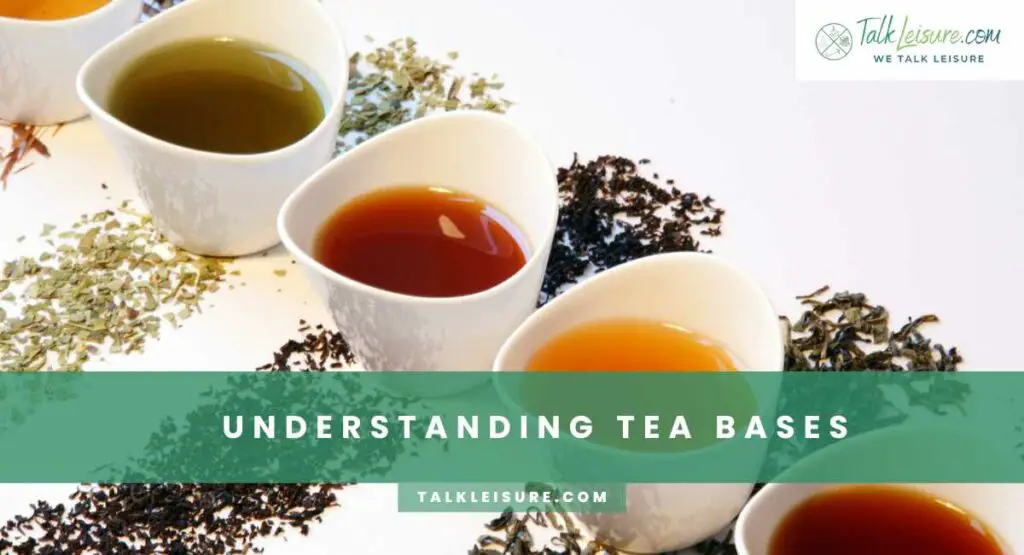
Welcome to the heart of tea blending—understanding your tea bases. Think of these as the canvas upon which you’ll paint your flavorful masterpiece. Let’s dive into the world of different tea types and their unique characteristics.
Exploring Different Types of Tea
Tea comes in a dazzling array of varieties, each with its own personality and flair. Here’s a quick rundown of the main players in the tea world:
- Black Tea: The bold, the robust, the wake-you-up-in-the-morning tea It’s hearty, it’s full-bodied, and it packs a caffeine punch. Think of it as the strong foundation for blends that mean business.
- Green Tea: The Zen Master of the Tea Family It’s fresh, it’s vibrant, and it’s all about that clean, grassy goodness. Green tea brings a gentle touch to blends, providing a soothing base for your creative endeavors.
- White Tea: The delicate darling of the tea world It’s light, it’s floral, and it’s all about subtlety. White tea lends an elegant and refined touch to blends, allowing other flavors to shine.
- Herbal Tea: Technically not a true tea (as it doesn’t come from the Camellia sinensis plant), herbal infusions are a playground of possibilities. From calming chamomile to zesty peppermint, herbal teas offer a blank canvas for your wildest flavor fantasies.
- Oolong Tea: The eEnigmaIt’s a bit of black, a bit of green, and a whole lot of intrigue. Oolong tea brings complexity and depth to blends, making it a versatile choice for those seeking a little mystery in their cup.
Their Flavor Profiles and Characteristics
Now, let’s talk flavor. Each tea type has its own distinct personality, ready to play a leading or supporting role in your blend.
- Black Tea: rich, bold, with a hint of astringency. It’s the foundation of hearty breakfast blends and chai masterpieces.
- Green Tea: is fresh, vegetal, and often slightly nutty. It’s the perfect backdrop for lighter, more delicate flavors.
- White Tea: Light, floral, with a touch of sweetness. It’s like a gentle whisper, allowing other ingredients to shine.
- Herbal Tea: This one’s a wild card! From the calming embrace of chamomile to the zesty kick of ginger, each herbal infusion has its own unique character.
- Oolong Tea: A dance of complexity, ranging from floral and fruity to toasty and nutty. It’s the chameleon of the tea world, adapting to the flavors it’s paired with.
Understanding these bases is like knowing the instruments in an orchestra. Each has its own role to play, and when orchestrated skillfully, they create a symphony of flavor that’s uniquely yours. So, armed with this knowledge, let’s move on to the next step in your tea-blending adventure!
Choosing Herbs, Spices, and Add-Ins
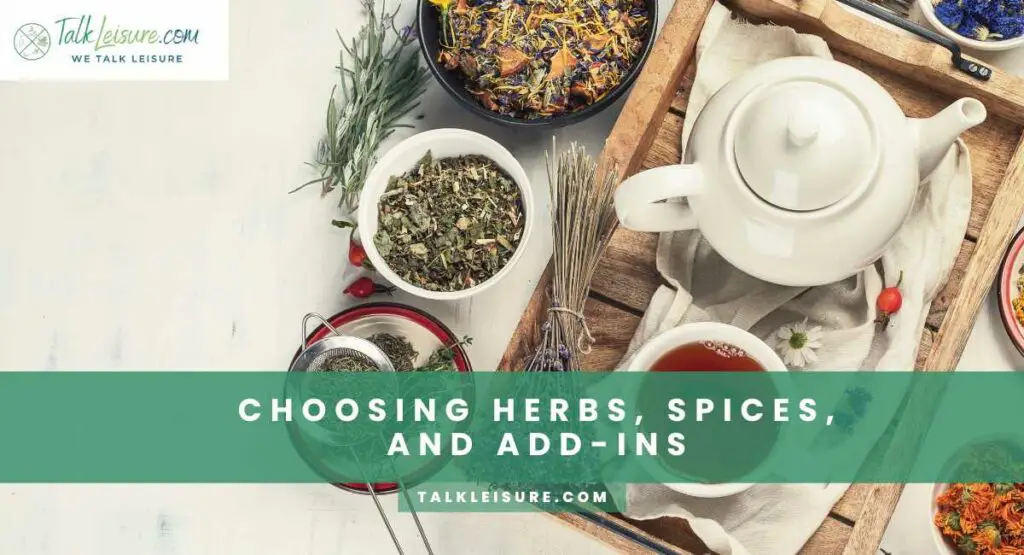
Here’s where the real fun begins! We’re about to dive into the world of herbs, spices, and all things aromatic. Get ready to unleash a burst of flavor and a plethora of health benefits into your tea blends.
Complementary Herbs and Spices for Flavor Enhancement
Think of herbs and spices as the paint on your palette, ready to add depth, character, and vibrancy to your tea blends. Here are some stellar choices to consider:
- Mint: This one’s a classic. It adds a refreshing zing to any blend and pairs beautifully with green or black teas.
- Lavender: Delicate and floral, lavender lends a touch of elegance to your cup. It’s perfect for creating calming blends.
- Cinnamon: Warm and inviting, cinnamon adds a cozy, comforting element. It’s like a hug in a cup.
- Ginger: Spicy and invigorating, ginger packs a punch. It’s fantastic for adding a bit of fire to your blends.
- Lemon Verbena: Zesty and citrusy, this herb brightens up any blend. It’s especially delightful with green tea.
- Cardamom: Exotic and aromatic, cardamom brings a touch of the East to your cup. It’s a star in chai blends.
Remember, it’s all about balance. A pinch of this, a dash of that—let your taste buds be your guide!
Health Benefits of Different Herbs and Spices
Now, let’s talk about the added bonus of blending with herbs and spices: the health benefits. Mother Nature has quite the medicine cabinet, and we’re about to raid it (in the most delicious way, of course).
- Peppermint: Soothes the digestive system and offers a burst of energy. It’s like a spa day for your insides.
- Chamomile: The ultimate relaxation herb. It eases stress, promotes sleep, and soothes the nerves.
- Turmeric: A powerhouse of anti-inflammatory goodness. It’s like a superhero for your immune system.
- Ginseng: Boosts energy and mental clarity. It’s your secret weapon for conquering the day.
- Rosemary: A memory enhancer and stress reducer. It’s like a brain-boosting elixir.
- Lemon Balm: Calms the mind and uplifts the spirits. It’s like a little ray of sunshine in your cup.
Blending with health benefits in mind? Now that’s what we call smart sipping!
With this arsenal of herbs and spices at your disposal, you’re not just creating tea blends; you’re crafting elixirs of well-being. So, get your mortar and pestle ready, and let’s infuse some magic into your teas!
How to Create an Ideal Tea Blend

Creating the perfect tea blend is a delightful blend of art and science. It’s all about understanding your ingredients, experimenting with flavors, and finding that harmonious balance that tickles your taste buds in just the right way. Here’s your step-by-step guide to crafting your own ideal tea blend:
- Know Your Ingredients: Familiarize yourself with the various teas, herbs, and flavorings at your disposal. Understand their unique characteristics and how they interact with one another.
- Start with a Base: Choose a primary tea base that forms the backbone of your blend. Whether it’s the robustness of black tea or the delicate notes of white tea, this sets the foundation for your creation.
- Complementary Flavors: Select herbs, spices, and additional flavorings that complement your base. Consider the synergy between ingredients and how they’ll come together to create a cohesive flavor profile.
- Experiment and Taste: Start with small batches and play with different ingredient ratios. Keep detailed notes on each experiment, noting what works and what needs adjustment.
- Balance is Key: Pay attention to the balance of flavors. You want each ingredient to shine without overpowering the others. Adjustments may be needed to achieve that perfect equilibrium.
- Consider Health Benefits: Think about the potential health benefits of your blend. Are there specific herbs or spices known for their soothing, invigorating, or therapeutic properties that align with your goals?
- Blend with Intention: As you mix your ingredients, infuse your blend with positive intentions or thoughts. This may sound a bit whimsical, but many believe it adds an extra layer of love and care to the process.
- Test and Refine: Don’t be afraid to taste, tweak, and taste again. It’s all part of the fun. Trust your palate and intuition.
- Packaging and Storage: Once you’ve achieved your ideal blend, ensure it’s stored in airtight containers away from moisture and light. This will help maintain its freshness and flavor.
- Labeling and Documentation: Clearly label your blend with its ingredients and any special brewing instructions. This ensures you can recreate your masterpiece in the future.
Remember, there’s no one-size-fits-all formula for the perfect blend. It’s a journey of discovery, guided by your unique taste preferences and creative instincts. So, gather your ingredients, trust your palate, and let the blending adventure begin!
Balancing Flavors: The Art of Tea Blending
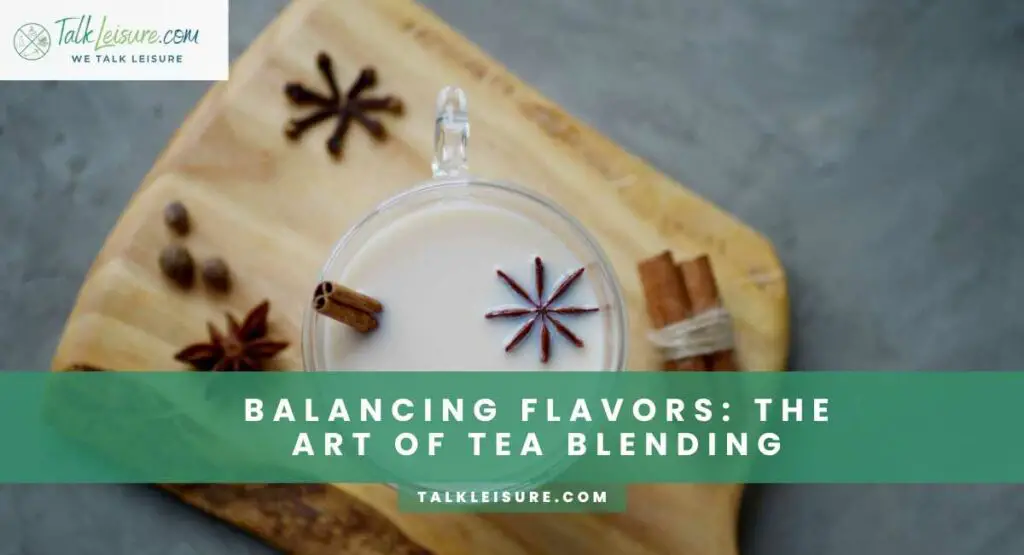
Welcome to the heart of tea blending—the art of balancing flavors. This is where we fine-tune, adjust, and refine our concoctions to create a symphony of taste. Here’s how you master this delicate dance:
Proportions and Ratios for a Well-Balanced Blend
Think of your tea blend as a recipe, and you’re the culinary genius. The right proportions and ratios are the secret ingredients to achieving that perfect harmony of flavors. Here are some guidelines to keep in mind:
- Base Tea: This forms the backbone of your blend. Generally, it’s about 70–80% of your total blend. Adjust based on the strength and character you want.
- Complementary Herbs and Spices: These are your supporting actors. Start with around 10–20% of your blend. They add depth and complexity.
- Additional Flavorings: Depending on intensity, these can range from a mere pinch to about 10%. They’re the finishing touches that elevate your blend.
Remember, these are just starting points. Trust your palate, and don’t be afraid to tweak the ratios until it sings to you.
Tips for Achieving Desired Flavor Profiles
Creating a well-balanced blend is like conducting an orchestra. Here are some tips to help you achieve the flavor profile you’re aiming for:
- Start Small: When experimenting with new ingredients, begin with small quantities. You can always add more, but you can’t take it out once it’s in!
- Layer Flavors: Start with your base and add complementary elements gradually. This allows you to taste how each component contributes to the overall flavor.
- Consider Brewing Time: Keep in mind that different ingredients may require varying steeping times. Some herbs and spices release their flavors quickly, while others require a bit more patience.
- Trust Your Senses: Pay attention to aroma, color, and of course, taste. Your senses are your best guides in this creative process.
- Take Notes: Document your experiments. What worked? What didn’t? These notes become your invaluable guidebook for future blends.
- Don’t Be Afraid to Get Creative: Sometimes, the most unexpected combinations yield the most delightful results. Trust your instincts and let your creativity flow.
Balancing flavors is an art that requires a blend of precision and intuition. With practice, you’ll develop an intuitive sense of what works and what doesn’t. So, grab your blending tools and let’s continue our journey into the world of tea alchemy!
Experimenting with Aromatics
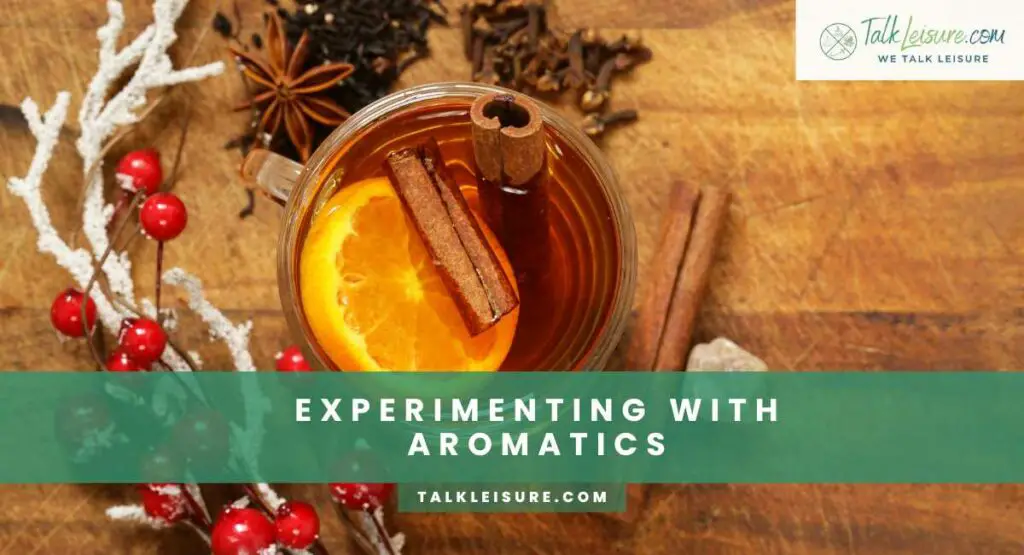
Welcome to the fragrant world of tea blending, where we infuse our concoctions with nature’s aromatic treasures. Here, we’ll explore the wonders of incorporating flowers and citrus peels into your blends and how they can transform both aroma and taste.
Incorporating Aromatics like Flowers and Citrus Peels
Aromatics are the magic wands of tea blending, adding a touch of whimsy and a burst of fragrance to your blends. Here are some delightful options to consider:
- Lavender: Delicate and floral, lavender lends a graceful touch to any blend. It’s like a stroll through a flower garden on a sunny day.
- Rose Petals: A romantic addition, rose petals infuse your blend with a subtle sweetness and a hint of nostalgia.
- Jasmine Flowers: Exotic and intoxicating, jasmine blossoms transport you to a fragrant garden in full bloom.
- Citrus Peels (Orange, Lemon, etc.): Zesty and vibrant, citrus peels add a burst of sunshine to your cup. They’re like a citrusy symphony for your taste buds.
- Hibiscus: Vibrantly red and refreshingly tart, hibiscus petals lend a tangy twist to your blends.
Remember, a little goes a long way with aromatics. Start with a small quantity and adjust to your taste preference.
Their Impact on Aroma and Taste
Aromatics aren’t just about pretty petals; they bring a whole new dimension to your blend:
- Aroma: Imagine opening a treasure chest of scents. Aromatics infuse your blend with enticing fragrances that tantalize your senses even before you take a sip. They elevate the entire tea-drinking experience.
- Taste: Aromatics impart subtle, nuanced flavors to your blend. Whether it’s the floral notes of lavender or the zesty kick of citrus, they interlace with the base and other ingredients, creating a multi-layered taste profile.
- Visual Appeal: Aromatics add visual flair to your blend. The vibrant colors of petals and peels turn your cup into a work of art.
- Emotional Impact: Aromatics have the power to evoke emotions and memories. The scent of lavender might bring calm, while the fragrance of roses might conjure feelings of romance.
Experimenting with aromatics is like adding a touch of poetry to your tea blend. They’re the finishing flourish that transforms a good blend into something truly extraordinary. So, let your imagination run wild, and let’s infuse some magic into your teas!
Storing and Packaging Your Blends
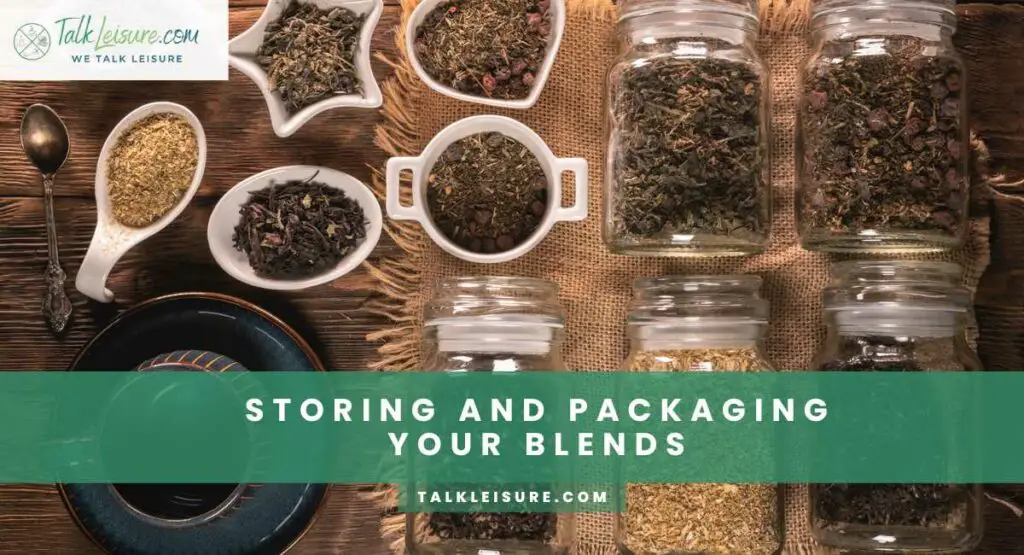
Ah, the final step before indulging in your carefully crafted blend – ensuring it stays fresh and presents itself beautifully. Let’s explore how to keep your blends at their best.
Proper Storage Techniques to Maintain Freshness
Your blend is a treasure, and it deserves to be treated as such. Follow these storage tips to keep its flavors vibrant:
- Airtight Containers: Invest in high-quality, airtight containers. They keep moisture and air out, preserving the integrity of your blend.
- Cool, Dark Place: Store your blends away from direct sunlight and in a cool, dry spot. Sunlight and heat can degrade the quality of your ingredients.
- Label with Dates: Note down the date of creation. This way, you’ll know when it’s time to freshen up your stock.
- Avoid Strong Odors: Keep your blends away from strong-smelling substances, as tea is quite the aroma sponge.
Creative Packaging Ideas for Gifting or Personal Use
Presentation matters, especially when it comes to gifting your delightful blends. Consider these creative packaging ideas:
- Decorative Tins or Jars: Elegant containers add a touch of sophistication. They’re not just vessels; they’re part of the gift.
- Custom Labels or Tags: Personalize your packaging with custom labels or tags. It adds a thoughtful touch and provides important information.
- Cellophane or Organza Bags: These translucent bags let the colors and textures of your blend shine through. They’re a simple yet effective packaging option.
- Ribbon or Twine Accents: A well-tied ribbon or twine not only secures the packaging but also adds a charming finishing touch.
Remember, packaging isn’t just about aesthetics; it also protects your blend and enhances the overall experience.
Labeling and Documentation
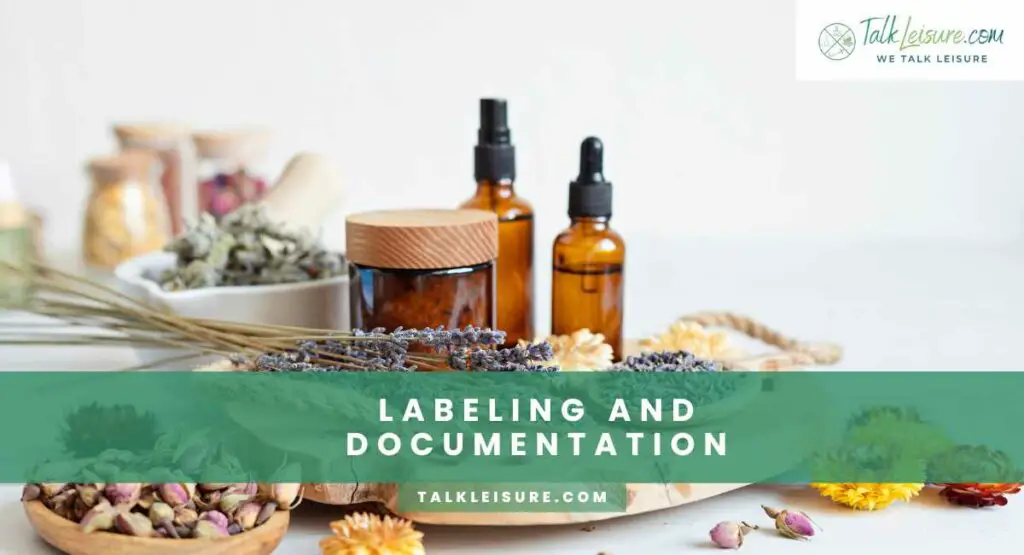
Keeping track of your blends is not just for the organized – it’s for the passionate tea blender who wants to recreate their masterpieces and share their art.
Importance of Labeling Your Tea Blends
Labels aren’t just pretty decorations; they’re essential:
- Identification: Labels help you quickly identify your blends. No more guessing games!
- Ingredients and Allergens: They provide crucial information, especially for those with dietary restrictions or allergies.
- Brewing Instructions: Guide your tea-drinking comrades on how to get the best out of your creation.
Keeping Track of Ingredients and Recipes for Future Reference
Documenting your tea blends is like creating a treasure map to your own secret garden of flavors:
- Ingredient Ratios: Note down the proportions of each component. It’s the key to recreating your blend.
- Tasting Notes: Jot down your impressions. What worked? What could be improved? This ensures continuous refinement.
- Special Brewing Instructions: If your blend has unique brewing needs, make sure to document them.
By labeling and documenting, you’re not only preserving your blend’s legacy but also empowering yourself to take your tea blending to new heights.
Safety and Health Considerations
Tea blending is an art, but it’s also a responsibility. Let’s dive into how to ensure your blends are not just delicious but also safe for consumption.
Ensuring Your Ingredients Are Safe for Consumption
Your tea blend should be a source of joy, not a concern. Here’s how to ensure it’s safe:
- Source Quality Ingredients: Purchase from reputable suppliers to ensure your ingredients meet safety standards.
- Check for Freshness: Regularly inspect your herbs, spices, and teas for any signs of spoilage or deterioration.
- Avoid Contaminants: Store your ingredients properly to prevent cross-contamination and maintain their integrity.
Addressing Allergies and Sensitivities
Caring for your tea-loving community means being mindful of allergies and sensitivities:
- Clearly Label Allergens: Make sure to highlight common allergens like nuts, gluten, or dairy in your blends.
- Offer Alternatives: Provide variations or substitutions for ingredients that may trigger allergies or sensitivities.
- Encourage Transparency: Encourage your tea-drinking friends to communicate any allergies or sensitivities they may have.
By prioritizing safety and health considerations, you ensure that everyone can enjoy your blends without worry. Happy, safe sipping!
With these steps, you’re not just a tea blender; you’re a curator of delightful experiences. Now, let’s share the magic of your personalized tea blends with the world!
DIY Tea Blending Recipes Worth Trying

Now that you’ve got the basics down, it’s time to dive into some tried-and-true tea blending recipes. These creations are crafted to delight your taste buds and showcase the art of tea blending. Let’s get blending!
Recipe 1: Morning Boost Blend – “Sunrise Serenade”
- Base: Green Tea (2 parts)
- Add-Ins: Lemongrass (1 part), Lemon Peel (1/2 part), Ginger (1/4 part)
Brewing Instructions: Steep 1 teaspoon of the blend in hot water for 3-4 minutes. Enjoy the zesty kickstart to your day!
Recipe 2: Relaxation Elixir – “Evening Tranquility”
- Base: Chamomile (3 parts)
- Add-Ins: Lavender Buds (1 part), Mint Leaves (1/2 part), Orange Peel (1/4 part)
Brewing Instructions: Infuse 1 teaspoon of the blend in hot water for 5-7 minutes. Let the calming aroma wash over you.
Recipe 3: Spiced Chai Bliss – “Cozy Comfort”
- Base: Black Tea (2 parts)
- Add-Ins: Cardamom Pods (1 part), Cinnamon Sticks (1 part), Cloves (1/2 part), Ginger (1/4 part)
Brewing Instructions: Simmer the blend in milk (or a milk substitute) for a rich, aromatic chai experience.
Recipe 4: Citrus Mint Refresher – “Zesty Zen”
- Base: Green Tea (2 parts)
- Add-Ins: Peppermint Leaves (1 part), Dried Orange Peel (1/2 part), Lemon Verbena (1/4 part)
Brewing Instructions: Steep 1 teaspoon of the blend in hot water for 2-3 minutes. Feel refreshed and rejuvenated!
Recipe 5: Floral Fantasy – “Blossom Breeze”
- Base: White Tea (2 parts)
- Add-Ins: Rose Petals (1 part), Jasmine Flowers (1 part), Lavender Buds (1/2 part)
Brewing Instructions: Infuse 1 teaspoon of the blend in hot water for 3-5 minutes. Let the delicate floral notes transport you.
Recipe 6: Spicy Herbal Infusion – “Fiery Fusion”
- Base: Herbal Blend (Rooibos or Peppermint) (2 parts)
- Add-Ins: Chili Flakes (1/2 part), Ginger (1/2 part), Cinnamon Sticks (1/4 part)
Brewing Instructions: Steep 1 teaspoon of the blend in hot water for 4-6 minutes. Embrace the warmth and spice!
Recipe 7: Fruity Delight – “Tropical Tango”
- Base: Black Tea (2 parts)
- Add-Ins: Dried Pineapple Chunks (1 part), Hibiscus Petals (1 part), Coconut Flakes (1/2 part)
Brewing Instructions: Infuse 1 teaspoon of the blend in hot water for 3-5 minutes. Experience a tropical getaway in a cup!
These recipes are just a starting point. Feel free to tweak and adjust to suit your taste preferences. Happy blending, and may your cup overflow with deliciousness!
Conclusion: Crafting Your Tea Legacy
Congratulations, dear tea enthusiast, on embarking on this flavorful journey of DIY tea blending. Through understanding tea bases, balancing flavors, and experimenting with aromatics, you’ve transformed into a true tea alchemist.
Remember, every cup you blend is a reflection of your unique taste and creativity. So, savor each sip, share your blends with fellow tea lovers, and continue to explore the boundless world of personalized tea creations. With a dash of passion and a sprinkle of creativity, your tea legacy will continue to steep and inspire for generations to come. Happy blending!
Frequently Asked Questions
- What is the most popular blend of tea?
The most popular blend of tea worldwide is likely English Breakfast. It’s a robust, full-bodied blend of black teas, often including Assam, Ceylon, and Kenyan varieties. It’s known for its bold flavor and is commonly consumed with milk and sugar.
- What is the healthiest tea in the world?
Green tea is often considered one of the healthiest teas in the world. It’s rich in antioxidants, particularly catechins like EGCG, which have numerous health benefits. Green tea is linked to improved brain function, fat loss, and a reduced risk of several diseases, including cancer and heart disease. It also contains various bioactive compounds that contribute to its health-promoting properties.
- What is the most expensive Ceylon tea?
The most expensive Ceylon tea is often associated with limited-edition or specialty varieties. For instance, “Golden Tips” or “Silver Tips” teas from Sri Lanka (formerly Ceylon) are considered among the priciest. These teas are made from the youngest, unopened tea buds, resulting in a rare and highly sought-after brew. The price can vary significantly depending on factors like rarity, quality, and production methods, with some exceptional Ceylon teas fetching hundreds or even thousands of dollars per kilogram.


